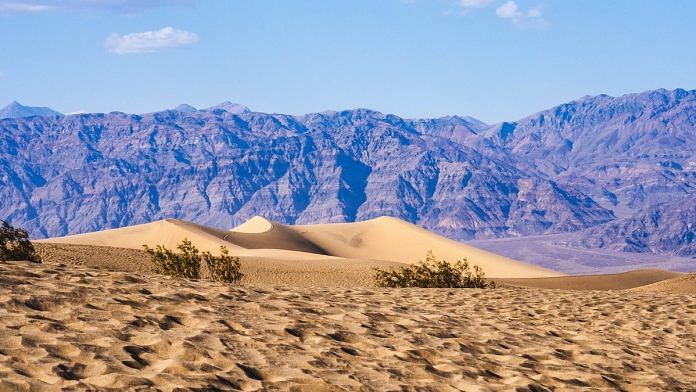Bengaluru: California’s Death Valley hit a record high of 54.4°C (or 130°F) Sunday afternoon in what could be the hottest reading ever reliably registered on Earth in modern history.
Death Valley is part of the Mojave Desert in North America. Furnace Creek, where the temperature was recorded, is considered to be one of the hottest places on earth, at par with deserts in the Arabian Peninsula and the Sahara. It is also the lowest, driest, and hottest location in the US, at 190-feet below sea level.
The temperature was recorded at 3.41 pm local time Sunday, according to the US National Weather Service. It will, however, have to be verified first by the World Meteorological Organization.
If proven correct, this weekend’s record will stand as the highest ever reliably recorded temperature in the world until broken.
Per the climate data in xmACIS2, this is the first time since 1913 that Death Valley has reached 130F. In July 2013, it last reached 129F. If valid, it would be the hottest August temperature at the site by 3F. @NWSVegas pic.twitter.com/gZNBW4NXI4
— NWS Weather Prediction Center (@NWSWPC) August 16, 2020
The west coast of North America has been reeling under a historic heat wave in the past several days. Multiple cities have broken record temperatures over the last week.
? ICYMI…yesterday was another one for the daily record books! In fact, Kingman, AZ tied their all-time high for August while Needles, CA broke theirs! ?️?
The Excessive Heat Warning continues! Find the latest updates and info at https://t.co/H4ycRSpCVQ! #cawx #nvwx #azwx pic.twitter.com/PgPN9UkrqD
— NWS Las Vegas (@NWSVegas) August 16, 2020
Also read: Antarctica temperature crosses 20 degrees Celsius for first time in history
Previous records
In modern history, higher temperatures have been recorded twice before. But there has been no way of ascertaining if those measurements were made reliably or accurate according to modern standards.
In 1931, the French town of Kebili in Tunisia had set a record of 55°C . Over a century ago, in 1913, Death Valley had famously recorded a high of 56.7°C.
But the Tunisian record is found to have colonial-era discrepancies and the 1913 Death Valley temperature deemed impossible “from a meteorological perspective” by some extreme weather experts.
So far, the two reliably recorded temperature highs have been at Mitribah in Kuwait in 2016 and Turbat in Pakistan in 2017. Both places had recorded a high of 54°C. A reliable reading at Death Valley in 2013 and Iraq’s Basra International Airport in 2016 had registered 53.9°C.
Sulaibiya in Kuwait again had recorded a 53.6°C in 2012, while Mohenjo-daro in Pakistan recorded 53.5°C in 2010.
According to the Intergovernmental Panel on Climate Change (IPCC), the world is currently seeing a temperature rise of 0.2°C per decade, and the average temperature of Earth has risen by over 1°C since the pre-industrial times. The Paris Agreement aims to curtail this rise by another half degree.
Rise in average temperatures aren’t similar in various geographical locations. The polar regions warm doubly as fast as the rest of the world, where hotter regions tend to get even hotter and colder landscapes warmer.
Extreme heat events
Heat wave in the US’ west coast has also brought with it other extreme events.
Wildfires, which are common at this time of the year, has been raging on with increased intensity, expanding rapidly in California’s Loyalton, destroying thousands of acres of forest land. The National Weather Service in Reno, Nevada, had for the first time ever issued a warning alert for a fire tornado.
Firenadoes form when wildfires generate large amount of smoke that rise up in a towering column of air to form a thundercloud, called a pyrocumulonimbus.
Electrically-charged pockets are formed in this cloud that discharge lightning. Fire whirls, a whirlwind induced by flames, rises up due to uneven heat distribution or an uneven terrain and creates a fire tornado.
Also read: NASA & ESA launch joint Solar Orbiter mission to study Sun’s poles






